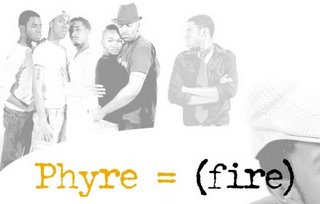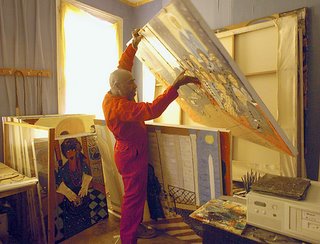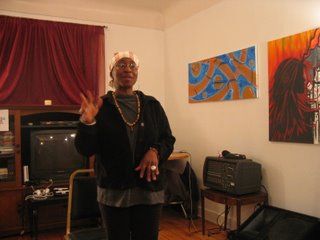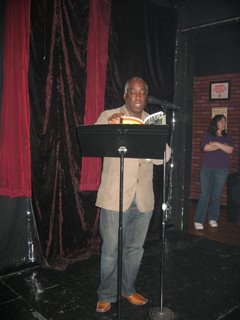Well, I've learned my lesson. I won't be commenting again on this blog about how unseasonably warm it is in Chicago, knowing full well my propensity for talking things up (as C will attest) and what this city and region, despite global warming, still have in store. Tonight It's 12F, without the wind chill factor, though I ventured out to a reading (which I'll blog about I hope tomorrow), I tried to spend as little time as I possibly could outdoors. This afternoon, between my morning and afternoon workshops, I decided (foolishly) to walk to the post office to mail some bills, and although I have never and will never have my face in a threshing machine, I was able to imagine the feeling just walking into the eastward wind. In addition, every morning, the sidewalks and my car have borne a light coat of snow and ice. It might not have been a White Christmas, but it's been a very White January.
Wherever in the vast plains those arctic winds are coming from, I wish they could go back. It is days and evenings like this that give me endless appreciation for whomever invented the radiator and thought of 7+ foot thick brick and concrete walls for houses and apartment buildings, and double-paned windows....
***
Another note about Chicago. Every day that I drive to and from Evanston, I say that I'm going to write about Chicago driving, even though I know full well from the statcounter associated with this blog that very few of my readers come from the Arctic City. But nevertheless, on the off chance that I have some Chicago readers other than my wonderful former students and a few colleagues, I am going to recommend one thing that even the worst drivers I have encountered driving in Boston (where, as I once told Reggie H. people were liable to drive backwards at upwards of 20 miles an hour down the street and then someone proceeded to illustrate my point, right then and there), or New Jersey (where the highways are basically raceways), or New York City (where you play a game sort of like Bumper Cars except that you never actually touch the other car, only at 10x the speeds), or Washington DC (which is a giant driving maze without walls), or anywhere else but Chicago appear to have learned during their period of learning how to handle an automobile. There is a lever which connects to a mechanism that creates a blinking light on either side of your car's front and rear lights. This mechanism is generally known as a turn signal or blinker. (I have no clue what the correct term is in Spanish, though I would guess it's something like
señal de vuelta, maybe, maybe not.) At any rate, these lights are very useful. They indicate when you plan to make a turn left or right, be it onto a street or into an alleyway or parking lot, or if you plan to change lanes, or if you aim to pull into a spot to park. In every other place that I've lived, most of the drivers realize that the turn signal/blinkers are for these multiple purposes. But not, it seems, in Chicago. Change lanes, often no signal. You signal you're going to park, and someone pulls right up behind you so you can barely back up; or they stop in the middle of the city's narrow residential streets, as if waiting to pick up someone, and lo, here they come backing up, into what could be one or two different parking spaces--but without a turn signal. And the person in front of you slows down to a crawl, with their break lights on? Are they going to stop for some reason? No, they're making a turn! I'm not sure why this basic aspect of driving is so hard for some of the good people out here to grasp, but I'm appealing to them: please learn to use your turn signal/blinkers. Please. You're not only doing yourself a huge favor, but everyone else as well. Please!
***
Today is the first day of
Black History Month, which I was fortunate to have been introduced to formally as a grade schooler, during those heady days in the early and mid-1970s when cultural affirmation was beginning to take root in many parts of the country. This was also not too long after the heyday of the Black Arts and Black Power movements, and so in addition to my introduction to Black history in school--in a Roman Catholic school, mind you, that went on to rename itself after the nation's first Black* Catholic bishop--I also took "African" dancing lessons and Black drawing classes and the like. It was not only edifying, but incredibly fun. (Especially those dances.) As I was in a predominantly Black environment at the time (though I'd gone to a multracial, multiethnic Montessori school for preschool), celebrating Black history seemed natural; nearly all the teachers and the students were Black, and the few White nuns and Fr. Ed appeared to go along with it (again, this was a very different period from today). Lining the hallways were the posters about famous Black people (from Harriet Tubman and Frederick Douglass to Mary McLeod Bethune and Ralph Bunche), and we learned a bit about famous Black people from Missouri, like our then-Congressman, Bill Clay, and Madame C.J. Walker, who'd lived in St. Louis, and George Washington Carver, as well as famous Black public figures, like the late Martin Luther King Jr. and Shirley Chisholm. (We didn't hear too much about famous Black entertainment figures from the state and city, like Chuck Berry, Redd Foxx, Dick Gregory, or Tina Turner, but then the emphasis was on certain types of role models, i.e., world leaders, scientists, and so forth, and not others, i.e., people in entertainment; Scott Joplin and Bobbie McFerrin Sr. were a few of the musicians whose work I remember hearing discussed, but I had to hear about the other famous St. Louis and St. Louis-area musicians, like Miles Davis, Clark Terry and Joe Bowie (of Art Ensemble of Chicago fame), and so on, at home.) I cannot recall if Anheuser-Busch had begun releasing its great Kings and Queens of Africa calendars and posters back then--I want to say they did, but I might be conflating memories--but I do know that non-American famous Black people, like Haile Selassie and Anwar al-Sadat were mentioned approvingly.

Then we moved to the suburbs, and I was no longer at a predominantly Black school, and wasn't getting any sort of exposure to Black history or culture outside my home or family or immediate neighborhood. I was in fact the only Black person in my class, and only one of
three Black children in the entire larger new school I attended. (My new neighbors up the street had already all graduated from the elementary school and were away in high school, while the other neighborhood kids went to a different school named, appropriately enough, after Frederick Douglass.) If any discussion of Black anything came up in any of my classes for those first two years, I don't remember it at all. At the next school I attended for junior high, I was one of two Black students in my class, and one of a little over a dozen in all 7-12th grade classes combined. In English we studied grammar and read poetry and fiction, none of it by anyone Black. In history, we learned about the Greeks and Romans and British (though none of the Black denizens of any of those cultures). In Latin and French and Musical Education--well, no Black people turned up at all. Religion, same thing. (The North African St. Augustine was a year away.) Around this time my parents joined one of those organizations (
not Jacks & Jills) which believed in bringing Black children, especially ones scattered about the suburbs, together to socialize. The organization or members hosted various events, and it was at one of the older kid's parties a few years later that I first heard "Rappers Delight." They also had a public recital, and though I was painfully shy, I did agree to participate in one of them. Around this time, I was becoming fascinated by Langston Hughes, whose work I knew about from early childhood on, though I didn't learn he was a native Missourian until reading one of those Black history posters. To me he was the most famous Black American poet (then and now), and though
Nikki Giovanni was my favorite at the time, I considered Hughes to be the poet whose work I should try to publicly recite. (I also thought of
Paul Lawrence Dunbar, but Hughes was more contemporary.)
So for the recital, I decided that I would memorize one of his poems, and I picked one of the most obvious, which I'd been familiar with from my prior Black history classes and books at home and at my godparents' homes: "
Dream Deferred." To me, it is one of the central poems of the Black American experience, and though I was terrified to death by the prospect of reciting this short poem aloud, when the time came, I got up and delivered it, I think without faltering. The one comment I remember after that experience was that a woman complimented me on the performance and on wearing my afro combed back "like Frederick Douglass." I don't remember "Dream Deferred" by heart anymore, but one of the pleasures of my class this past fall was that I had the opportunity to read it again with students. Here it that poem, by an artist and figure I adore more and more as I grow older,
(James Mercer) Langston Hughes (1902-1967), whose birthday is today:
Dream DeferredWhat happens to a dream deferred?
Does it dry up
Like a raisin in the sun?
Or fester like a sore--
And then run?
Does it stink like rotten meat?
Or crust and sugar over--
like a syrupy sweet?
Maybe it just sags
like a heavy load.
Or does it explode?
And here is another poem by him, that captures in all its simplicity the spirit of
Carter G. Woodson's original "Black History Week" and now, of
Black History Month, "
My People":
My PeopleThe night is beautiful,
So the faces of my people.
The stars are beautiful,
So the eyes of my people.
Beautiful, also, is the sun.
Beautiful, also, are the souls of my people.
Both poems © Estate of Langston Hughes, 2007.





















 What a summery day we had in Chicago this afternoon: it reached 15 F. Meanwhile, in the wider world, the news includd the imminent coming out by a former
What a summery day we had in Chicago this afternoon: it reached 15 F. Meanwhile, in the wider world, the news includd the imminent coming out by a former 
 Then we moved to the suburbs, and I was no longer at a predominantly Black school, and wasn't getting any sort of exposure to Black history or culture outside my home or family or immediate neighborhood. I was in fact the only Black person in my class, and only one of
Then we moved to the suburbs, and I was no longer at a predominantly Black school, and wasn't getting any sort of exposure to Black history or culture outside my home or family or immediate neighborhood. I was in fact the only Black person in my class, and only one of